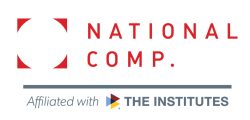National Comp 2022 RFP Is Open! Submit a Proposal to Speak This October

For 2022, there is no shortage of concerns or topics to address, while our workplaces continue to face new challenges each day. The National Comp 2022 program will showcase a spectrum of workers’ comp and injury prevention topics, and we invite all ideas that elevate the workers’ compensation industry through shared strength and knowledge.
 We seek educational material well suited for hour-long presentations, but also for CompTalks – our special 15-minute presentations showcased at National Comp Theater. Whether short-form or long-form, we’d love to see proposals on everything you’re passionate about sharing. To fire your idea engine, here are some of the topics currently being discussed behind the scenes at National Comp.
We seek educational material well suited for hour-long presentations, but also for CompTalks – our special 15-minute presentations showcased at National Comp Theater. Whether short-form or long-form, we’d love to see proposals on everything you’re passionate about sharing. To fire your idea engine, here are some of the topics currently being discussed behind the scenes at National Comp.
- Managing pandemic and endemic risks, what we know now, current challenges and preparing for the future
- The talent gap and the training gap: Ensuring safety training doesn’t fall through the cracks in a difficult labor environment
- What “The Great Resignation” means for claims. This growing trend brings a cornucopia of risks, from maintaining top talent throughout the workers’ comp industry, to the loss of vital safety knowledge and experience across all industries. Where should leaders focus in order to have the most impact on these growing concerns?
- How big a risk is Long Covid – and are we prepared?
- The New Worker Experience: As young workers entering the workforce and experience veterans retire, how do we set our new workforce up to absorb the safety message and to work safely every day from Day One on the job?
- Smart strategies for managing employee mental health: How to get ahead of the risk through education, training, outreach and more.
- The ever-evolving legal and regulatory landscape. What are the trends significantly impacting large numbers of employers and claims payers, now and moving into 2023?
- Prescription drug prices have risen by 33 percent since 2014 by some reports. Prescription drugs account for around 14% of a workers’ comp claim on average. What are some of the specific strategies and practices that are making a difference for PBMs, payers and employers?
- The Risk of “Mega” claims: Some data suggests that the number of claims topping $5 million will continue to rise. Catastrophic injury claims can reach $10 to $15 million. We’re looking for the latest guidance on how employers and payers are successfully reining in claims before they snowball into mega-claims.
- Maximizing the benefits of physical therapy programs. What will employers and payers need to know to ensure the best care as costs begin to rise?
- Workplace-related mental injury was once the smallest slice of the claims pie. But the pandemic accelerated growing trends and brought new ones. This time last year, NCCI was monitoring approximately 40 proposed state bills addressing workers’ compensation for mental injuries, including more than 30 related to post-traumatic stress disorder. What are the tools payers and employers need to best protect their people as well as their organizations?
- As opioid prescribing has declined, topical analgesics have become an increasingly common factor in the treatment of musculoskeletal and neuropathic pain in workers’ comp, and therefore a growing prescription cost driver. How can we reduce the risk of misuse and maximize outcomes during patient recovery?
- Non-pharmaceutical solutions for pain management. Acupuncture, yoga, meditation, cognitive behavioral therapy and much more have been part of the pain management conversation for a long time. It’s time for a closer look at how these programs and practices are being utilized in real-world workers’ comp settings, and whether they have the potential to make a greater impact on recovery outcomes and pharmaceutical costs.
- What’s climate change got to do with workers’ comp? Maybe more than we realize. Increases in natural disasters and catastrophic weather events should be giving leaders pause. As hurricanes, fires, and tornadoes increase in number and severity, what will that mean both for claims organizations, and for employers’ ability to ensure the safety of their workforce?
- Next-level safety solutions for high-risk industries. As industries face the challenges of tight staffing, inexperienced workers and difficulty maintaining safety oversight, what are the most difficult challenges that have emerged, and what new technologies and programs have emerged to fill those gaps. Chairs’ note: Specific product endorsements will be declined.
- Advances in medical technology and durable medical equipment are giving injured workers back their lives, but the associated costs can be extreme. How should insurers and claims organizations balance the cost of new medical technology with the impact on recovery for injured workers? How do they determine the appropriate care to achieve the best outcomes?
- Demystifying the actuary report, including what it means for managing incurred but not reported (IBNR) claims. Seeking employer and actuary co-presenters to outline key considerations for self-insured programs.
- Improving outcomes and controlling costs when you can’t direct care. With more states considering changes in legislation, what are the new and existing strategies leading to solid, measurable results?
- Capitalizing on and furthering the gains of telehealth. Are we getting telemedicine right? How do we apply the best of what we’ve learned? And how do we identify and solve for the pitfalls that could add additional or inappropriate costs?
- While many industries have remained in-person by necessity, others have adopted hybrid models, while some continue to work mostly, or perhaps entirely, via remote locations. What are long-term impacts of this transition – how does the industry need to change or develop in order to continue meeting all employers’ needs proactively?
- Some employers embraced the wellness message a decade ago while others are still exploring their options and needs. With increased attention to overall workforce health and wellness and its impact on workplace injuries and recovery, now is the time to focus on wellness strategies that engage the workforce and provide meaningful results.
- Cannabis and claims: We know where it’s legal and where it’s not. But does it work? What are the appropriate and effective applications for medical marijuana and CBD?
Please keep in mind this list is intended for brainstorming purposes. We’re eager to hear your perspective on the key pressures impacting your organization, your peers or your clients right now. What is the need to know information, what are the lessons learned that could apply to —and benefit — a broader audience?
Reviewers will evaluate all proposals based on overall quality, relevance to the industry, defined focus within the educational track structure, practical applications of material for attendees, timeliness of the topic and speakers’ qualifications. &
Learn more on the National Comp website and submit your best ideas today!










